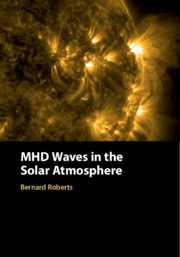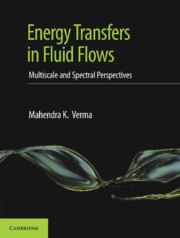Refine search
Actions for selected content:
8123 results in Fluid dynamics and solid mechanics
Preface
-
- Book:
- MHD Waves in the Solar Atmosphere
- Published online:
- 15 July 2019
- Print publication:
- 18 July 2019, pp xvii-xx
-
- Chapter
- Export citation
5 - Magnetic Slabs
-
- Book:
- MHD Waves in the Solar Atmosphere
- Published online:
- 15 July 2019
- Print publication:
- 18 July 2019, pp 102-138
-
- Chapter
- Export citation
4 - Surface Waves
-
- Book:
- MHD Waves in the Solar Atmosphere
- Published online:
- 15 July 2019
- Print publication:
- 18 July 2019, pp 83-101
-
- Chapter
- Export citation
12 - Damping
-
- Book:
- MHD Waves in the Solar Atmosphere
- Published online:
- 15 July 2019
- Print publication:
- 18 July 2019, pp 360-396
-
- Chapter
- Export citation
11 - Thin Flux Tubes: The Kink Mode
-
- Book:
- MHD Waves in the Solar Atmosphere
- Published online:
- 15 July 2019
- Print publication:
- 18 July 2019, pp 311-359
-
- Chapter
- Export citation
Frontmatter
-
- Book:
- MHD Waves in the Solar Atmosphere
- Published online:
- 15 July 2019
- Print publication:
- 18 July 2019, pp i-iv
-
- Chapter
- Export citation
10 - Thin Flux Tubes: The Sausage Mode
-
- Book:
- MHD Waves in the Solar Atmosphere
- Published online:
- 15 July 2019
- Print publication:
- 18 July 2019, pp 281-310
-
- Chapter
- Export citation
13 - Nonlinear Aspects
-
- Book:
- MHD Waves in the Solar Atmosphere
- Published online:
- 15 July 2019
- Print publication:
- 18 July 2019, pp 397-433
-
- Chapter
- Export citation
7 - The Twisted Magnetic Flux Tube
-
- Book:
- MHD Waves in the Solar Atmosphere
- Published online:
- 15 July 2019
- Print publication:
- 18 July 2019, pp 182-206
-
- Chapter
- Export citation
2 - Waves in a Uniform Medium
-
- Book:
- MHD Waves in the Solar Atmosphere
- Published online:
- 15 July 2019
- Print publication:
- 18 July 2019, pp 27-65
-
- Chapter
- Export citation
3 - Magnetically Structured Atmospheres
-
- Book:
- MHD Waves in the Solar Atmosphere
- Published online:
- 15 July 2019
- Print publication:
- 18 July 2019, pp 66-82
-
- Chapter
- Export citation
1 - General Principles
-
- Book:
- MHD Waves in the Solar Atmosphere
- Published online:
- 15 July 2019
- Print publication:
- 18 July 2019, pp 1-26
-
- Chapter
- Export citation
Contents
-
- Book:
- MHD Waves in the Solar Atmosphere
- Published online:
- 15 July 2019
- Print publication:
- 18 July 2019, pp vii-xvi
-
- Chapter
- Export citation

MHD Waves in the Solar Atmosphere
-
- Published online:
- 15 July 2019
- Print publication:
- 18 July 2019
LYAPUNOV EXPONENTS OF THE KURAMOTO–SIVASHINSKY PDE
- Part of
-
- Journal:
- The ANZIAM Journal / Volume 61 / Issue 3 / July 2019
- Published online by Cambridge University Press:
- 15 July 2019, pp. 270-285
-
- Article
-
- You have access
- Export citation
FULLY 3D RAYLEIGH–TAYLOR INSTABILITY IN A BOUSSINESQ FLUID
- Part of
-
- Journal:
- The ANZIAM Journal / Volume 61 / Issue 3 / July 2019
- Published online by Cambridge University Press:
- 01 July 2019, pp. 286-304
-
- Article
-
- You have access
- Export citation

Energy Transfers in Fluid Flows
- Multiscale and Spectral Perspectives
-
- Published online:
- 12 June 2019
- Print publication:
- 23 May 2019
ANZ VOLUME 61 ISSUE 2 COVER AND BACK MATTER
-
- Journal:
- The ANZIAM Journal / Volume 61 / Issue 2 / April 2019
- Published online by Cambridge University Press:
- 04 June 2019, pp. b1-b6
-
- Article
-
- You have access
- Export citation
ANZ VOLUME 61 ISSUE 2 COVER AND FRONT MATTER
-
- Journal:
- The ANZIAM Journal / Volume 61 / Issue 2 / April 2019
- Published online by Cambridge University Press:
- 04 June 2019, pp. f1-f2
-
- Article
-
- You have access
- Export citation
26 - Rotating Turbulence
- from Part IV - MISCELLANEOUS FLOWS
-
- Book:
- Energy Transfers in Fluid Flows
- Published online:
- 12 June 2019
- Print publication:
- 23 May 2019, pp 429-442
-
- Chapter
- Export citation
